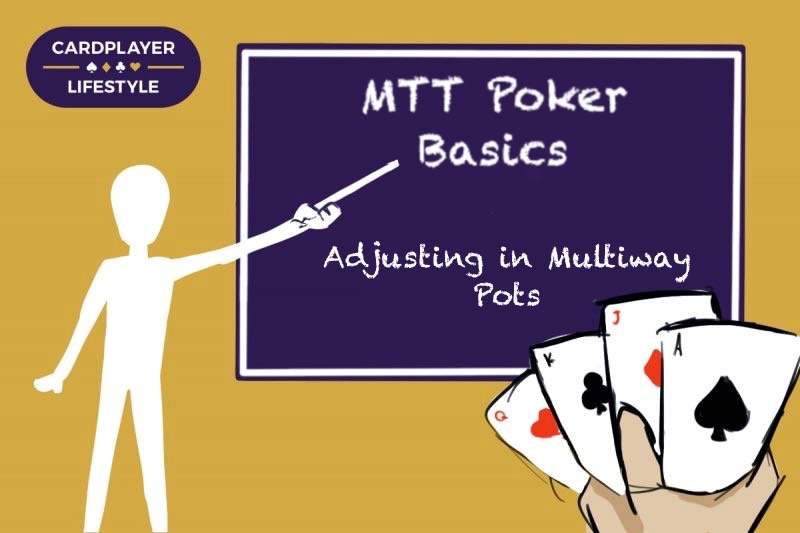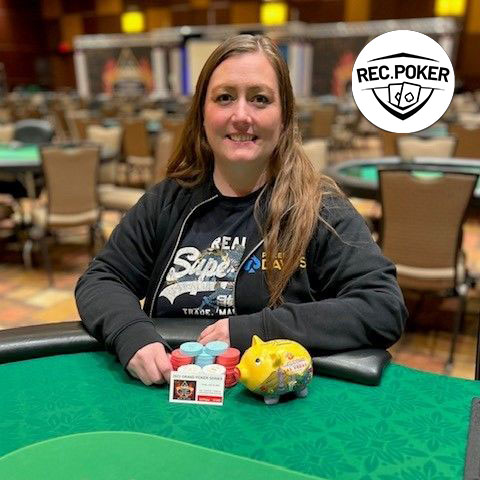Ed. note: This is the fourth in a series of articles designed to help recreational tournament poker players build their hobby into a profitable endeavor.
In this MTT Poker Basics series, we often discuss game theory optimal strategies to win in the challenging positions that present themselves time and time again. But even in the world of solvers, some areas remain a mystery. And spots become their most puzzling once you start playing multiway pots.
The majority of solved poker positions you will ever learn from are based on single-raised pots (SRPs), and for good reason. The more player positions and ranges you add to the equation, the more possibilities there are to consider. The gametree runs deeper, with too many options to consider. It makes completely solving the position nearly impossible.
Thankfully, there are still principles that can be applied that ensure you maintain an advantage against multiple opponents. Let’s dive in and explore the many possibilities in these complicated tournament situations.

Becoming more passive
Forget making a pair; sometimes it’s hard enough to find a playable hand pre-flop. When you have been card dead for levels at a time, you may welcome hands like ATs from an early position with open arms. But when you have two in position callers plus the big blind, it can feel like disaster has struck for your first welcome sight in some time.
In times like these, your instinct may be to c-bet any board as the pre-flop aggressor. You have the range advantage, after all. You haven’t been playing hands recently. It’s time for these other players to show your position a little bit of respect!
Unfortunately, all your bravado be damned, hands like ATs will not work this way in a multiway pot. Despite these calling ranges being relatively weak, they are still going to contain showdown value the vast majority of the time. You will see your opponents flatting an abundance of pocket pairs that will be willing to float vs your no equity c-bet on low paired boards, for example. Any variety of middling boards will surely connect with the multiple ranges that have decided to flat your raise as well.
It may feel like a surefire way to lose the pot, but realistically, you are going to want to either play passively or straightforward for value in multiway pots. Ace high and King high hands will have a difficult time winning, but they’re your best shot when playing vs. multiple opponents on uncomfortable board textures. The hard truth is that you aren’t going to bluff multiple people off a board you rarely connect with, so you shouldn’t make a habit of turning your reasonable showdown hands into bluffs.
Hand strength and equity will be minimized as it is divided amongst multiple players. As a result, you can find reasonable folds with gutshots, weak bottom pairs, and other marginal holdings facing a strong bet and call out of position. On the other hand, you can also find yourself leading out of position as the preflop aggressor with strong overpairs on safe boards. This can simplify things quickly and clean up your equity in a pot while you are often still ahead.
In general, you want to focus your continuing range around your strongest equity hands. They will need plenty of support to withstand multiple streets of aggression against more than one opponent as the pot size grows exponentially. And when you don’t have much equity? It is perfectly fine to be passive, folding a pretty hand that’s brought a knife to a gunfight.
Understanding when you have a range advantage or not
In multiway pots, you’ll need to have a strong understanding of the ranges at play, walking a thin line for value. Always be asking yourself what your opponents ranges should look like pre-flop from their positions, along with their given actions post-flop.
Sticking with the ATs example, let’s imagine we see an A84 rainbow flop out of position vs three opponents. You have the top pair and all of the best Aces in your range. Your instinct may be to fire out a c-bet. And on certain Ace high boards, that would be reasonable. However, in this case, we’ve found a classic example of being way ahead or way behind.
Think back to the preflop action. You’ve raised early position, and at least one player from middle position had a hand strong enough to just call vs your raise. At deeper stack depths, that range contains plenty of pocket pairs, suited Broadway stuff, sure. But AJ and AQ combos are mixing call and 3bet, even prioritizing a call when they are suited. So in this case, it’s worth checking to this particularly strong range with the intention to happily call. Without front door flush draws or straight draws to consider, our top pair doesn’t have much to protect against. So there’s no reason to build a large pot with our medium strength hand that’s unlikely to improve.
Multiway pots rightfully get a bad reputation for opponents playing too many hands, but it’s important to remember that the initial caller didn’t sign up for all this action. They were ready to play a single-raised pot vs. your extremely strong range, and that shouldn’t be forgotten once you make a hand.
Jonathan Little has a great primer on multiway pots available on YouTube. Check out the video below for a more expansive look at the ideas shared here so far. If you’re looking for even more training in this specific area, Pokercoaching.com has much to offer.
Embracing the squeezed pot
Multiway pots are a chore to handle post-flop, it’s true. The fact of the matter is that once you’re in one, it can be difficult to win without real showdown value. So when asked how to win these hands when you aren’t supposed to, my answer is simple: you can’t. Just avoid them altogether.
As the pre-flop raiser, you’re at the mercy of your competition’s decision making and may face uncomfortable multiway situations. But when you are in position facing multiple players in the pot, you should prefer to make a large 3-bet with lots of playable hands. Even against a raise and one call, the majority of hands in your range will mix between calling and reraising. If you are the fourth player to enter a pot, you can’t go wrong squeezing pocket pairs above 77, AQo+, or any suited Broadway hand.
A standard 3-bet in position is 3.5x when deeper stacked, so a squeeze vs. multiple players will add a big blind or so for each caller. This gives you a strong range advantage post-flop in position when you don’t take it down beforehand. Outside of the original raiser, any opponents that make it post-flop with you will have shown a definitively medium strength hand, making it difficult to handle further aggression.
Your goal as a poker player should be to play pots vs. as few opponents as possible. You may not be able to control that as an early position raiser, but make it a priority to never build a multiway pot yourself unnecessarily!
Solving the mysterious pots
Multiway pots are a mysterious minefield to navigate. Significant errors in these pots can add up fast, leaving you dizzy and short-stacked.
Unfortunately, there aren’t perfect solutions either. These spots are outside the realm of traditionally solved, game theory optimized positions. And you’ll notice that this tricky situation comes up often, particularly in live poker. Similar to playing from the small blind, you should simply aim to lose the minimum here and break up the situation altogether, if you can.
When people bemoan the rise of GTO and solvers as “the end of poker”, they are sorely mistaken. These spots are a gray area that keeps poker alive and well. But as a player learning the fundamentals, embracing strategies that work in the long run, you can cut through the fog and fight back to see the game clearly. Following these fundamentals will help you navigate this minefield carefully while your opponents implode, questioning where things went wrong.




